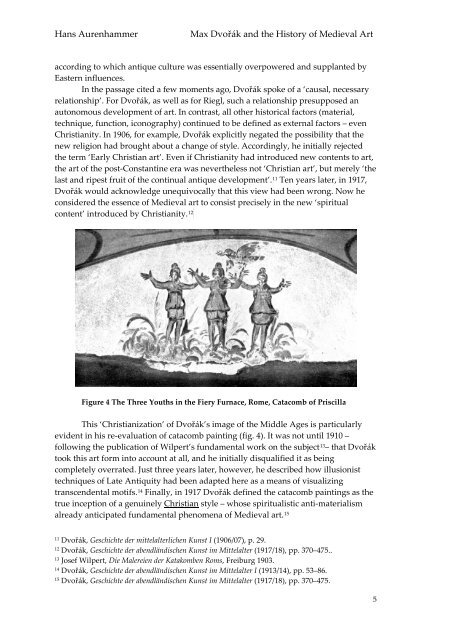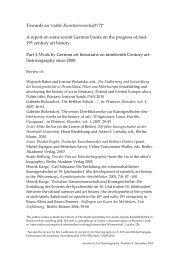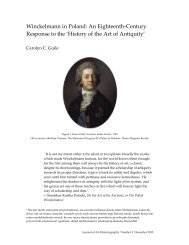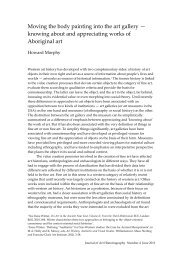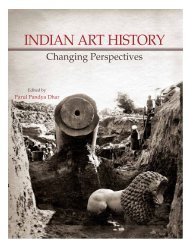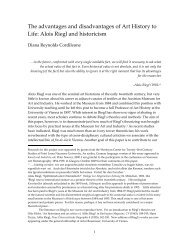Max Dvorák und die Revision der Mittelalter-Kunstgeschichte im ...
Max Dvorák und die Revision der Mittelalter-Kunstgeschichte im ...
Max Dvorák und die Revision der Mittelalter-Kunstgeschichte im ...
You also want an ePaper? Increase the reach of your titles
YUMPU automatically turns print PDFs into web optimized ePapers that Google loves.
Hans Aurenhammer <strong>Max</strong> Dvořák and the History of Me<strong>die</strong>val Art<br />
according to which antique culture was essentially overpowered and supplanted by<br />
Eastern influences.<br />
In the passage cited a few moments ago, Dvořák spoke of a ‘causal, necessary<br />
relationship’. For Dvořák, as well as for Riegl, such a relationship presupposed an<br />
autonomous development of art. In contrast, all other historical factors (material,<br />
technique, function, iconography) continued to be defined as external factors – even<br />
Christianity. In 1906, for example, Dvořák explicitly negated the possibility that the<br />
new religion had brought about a change of style. Accordingly, he initially rejected<br />
the term ‘Early Christian art’. Even if Christianity had introduced new contents to art,<br />
the art of the post-Constantine era was nevertheless not ‘Christian art’, but merely ‘the<br />
last and ripest fruit of the continual antique development’. 11 Ten years later, in 1917,<br />
Dvořák would acknowledge unequivocally that this view had been wrong. Now he<br />
consi<strong>der</strong>ed the essence of Me<strong>die</strong>val art to consist precisely in the new ‘spiritual<br />
content’ introduced by Christianity. 12<br />
Figure 4 The Three Youths in the Fiery Furnace, Rome, Catacomb of Priscilla<br />
This ‘Christianization’ of Dvořák’s <strong>im</strong>age of the Middle Ages is particularly<br />
evident in his re-evaluation of catacomb painting (fig. 4). It was not until 1910 –<br />
following the publication of Wilpert’s f<strong>und</strong>amental work on the subject 13 – that Dvořák<br />
took this art form into account at all, and he initially disqualified it as being<br />
completely overrated. Just three years later, however, he described how illusionist<br />
techniques of Late Antiquity had been adapted here as a means of visualizing<br />
transcendental motifs. 14 Finally, in 1917 Dvořák defined the catacomb paintings as the<br />
true inception of a genuinely Christian style – whose spiritualistic anti-materialism<br />
already anticipated f<strong>und</strong>amental phenomena of Me<strong>die</strong>val art. 15<br />
11 Dvořák, Geschichte <strong>der</strong> mittelalterlichen Kunst I (1906/07), p. 29.<br />
12 Dvořák, Geschichte <strong>der</strong> abendländischen Kunst <strong>im</strong> <strong>Mittelalter</strong> (1917/18), pp. 370–475..<br />
13 Josef Wilpert, Die Malereien <strong>der</strong> Katakomben Roms, Freiburg 1903.<br />
14 Dvořák, Geschichte <strong>der</strong> abendländischen Kunst <strong>im</strong> <strong>Mittelalter</strong> I (1913/14), pp. 53–86.<br />
15 Dvořák, Geschichte <strong>der</strong> abendländischen Kunst <strong>im</strong> <strong>Mittelalter</strong> (1917/18), pp. 370–475.<br />
5


